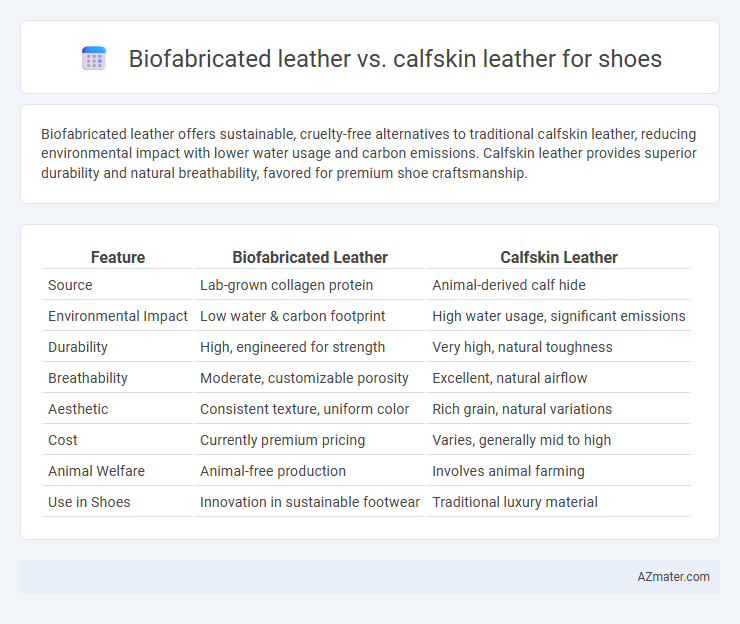Biofabricated leather offers sustainable, cruelty-free alternatives to traditional calfskin leather, reducing environmental impact with lower water usage and carbon emissions. Calfskin leather provides superior durability and natural breathability, favored for premium shoe craftsmanship.
Table of Comparison
| Feature | Biofabricated Leather | Calfskin Leather |
|---|---|---|
| Source | Lab-grown collagen protein | Animal-derived calf hide |
| Environmental Impact | Low water & carbon footprint | High water usage, significant emissions |
| Durability | High, engineered for strength | Very high, natural toughness |
| Breathability | Moderate, customizable porosity | Excellent, natural airflow |
| Aesthetic | Consistent texture, uniform color | Rich grain, natural variations |
| Cost | Currently premium pricing | Varies, generally mid to high |
| Animal Welfare | Animal-free production | Involves animal farming |
| Use in Shoes | Innovation in sustainable footwear | Traditional luxury material |
Introduction to Biofabricated and Calfskin Leather
Biofabricated leather is a sustainable material produced through cellular agriculture, mimicking the structure of traditional leather without the environmental impact of animal farming. Calfskin leather, derived from the hides of young cattle, is prized for its smooth texture, durability, and natural breathability, making it a premium choice in luxury shoe manufacturing. The comparison hinges on biofabricated leather's eco-friendly production process versus calfskin's established heritage and performance in footwear applications.
What Is Biofabricated Leather?
Biofabricated leather is an innovative material created through cellular agriculture or biotechnology, producing leather-like material without using animal hides. It offers a sustainable alternative to traditional calfskin leather, reducing environmental impact by eliminating the need for livestock farming and tanning processes. This lab-grown leather replicates the texture, durability, and flexibility of calfskin, making it ideal for high-quality shoe manufacturing.
Understanding Calfskin Leather
Calfskin leather, derived from young cattle, is prized for its softness, fine grain, and durability, making it a premium choice for high-quality shoes that mold comfortably over time. It offers natural breathability and moisture-wicking properties that enhance foot comfort and longevity. In contrast, biofabricated leather mimics these characteristics through sustainable lab-grown materials, aiming to reduce environmental impact while replicating calfskin's texture and performance.
Environmental Impact: Biofabricated vs Calfskin Leather
Biofabricated leather significantly reduces environmental impact by minimizing water consumption and greenhouse gas emissions compared to traditional calfskin leather, which involves resource-intensive livestock farming. The production of biofabricated leather generates fewer pollutants and eliminates the need for harmful tanning chemicals commonly used in calfskin processing. Sustainable sourcing and lower carbon footprint make biofabricated leather a preferable choice for eco-conscious shoe manufacturing.
Durability and Performance Comparison
Biofabricated leather offers high durability with resistance to cracking and water damage, often outperforming traditional calfskin leather in wear longevity. Calfskin leather provides natural breathability and flexibility, supporting superior comfort and performance, but may require more maintenance to prevent wear. Both materials perform well in shoe applications, with biofabricated leather excelling in sustainability and calfskin favored for its classic texture and aging characteristics.
Aesthetic Differences in Shoe Crafting
Biofabricated leather offers a more uniform texture and consistent color, enabling designers to achieve sleek, modern aesthetics in shoe crafting. Calfskin leather, valued for its natural grain variations and rich patina, delivers a classic, luxurious appearance that enhances with wear. The choice between the two impacts the visual character and aging process of the final shoe product.
Cost Analysis: Production and Retail Prices
Biofabricated leather production costs remain higher due to advanced biotechnological processes and limited large-scale manufacturing facilities, resulting in elevated retail prices compared to traditional calfskin leather. Calfskin leather benefits from established supply chains and mass production economies, keeping costs lower and more competitive in the footwear market. Despite premium pricing, biofabricated leather offers potential long-term savings through ethical sourcing and reduced environmental compliance expenses.
Consumer Perception and Market Trends
Biofabricated leather is gaining traction among eco-conscious consumers who prioritize sustainability and animal welfare, driving market demand for alternative materials in the footwear industry. Calfskin leather remains favored for its durability, luxury appeal, and traditional craftsmanship, maintaining strong market presence in premium shoe segments. Current trends reveal a growing consumer shift towards biofabricated leather due to increasing environmental awareness and advancements in material quality that challenge conventional calfskin's dominance.
Ethical Considerations in Material Choice
Biofabricated leather offers a sustainable and cruelty-free alternative to traditional calfskin leather, significantly reducing animal harm and environmental impact. The production of biofabricated leather relies on cultured cells or plant-based materials, eliminating the need for livestock farming that contributes to deforestation and greenhouse gas emissions. Choosing biofabricated leather supports ethical consumption by promoting animal welfare and lowering carbon footprint in the fashion industry.
The Future of Leather in Footwear Industry
Biofabricated leather, produced through sustainable biotechnology, offers a promising alternative to traditional calfskin leather by reducing environmental impact and ethical concerns related to animal farming. This innovative material mimics the durability, flexibility, and aesthetic qualities of calfskin, making it suitable for high-quality footwear production. As the footwear industry embraces sustainability, biofabricated leather is poised to become a dominant material choice, aligning with consumer demand for eco-friendly and cruelty-free products.

Infographic: Biofabricated leather vs Calfskin leather for Shoe
 azmater.com
azmater.com